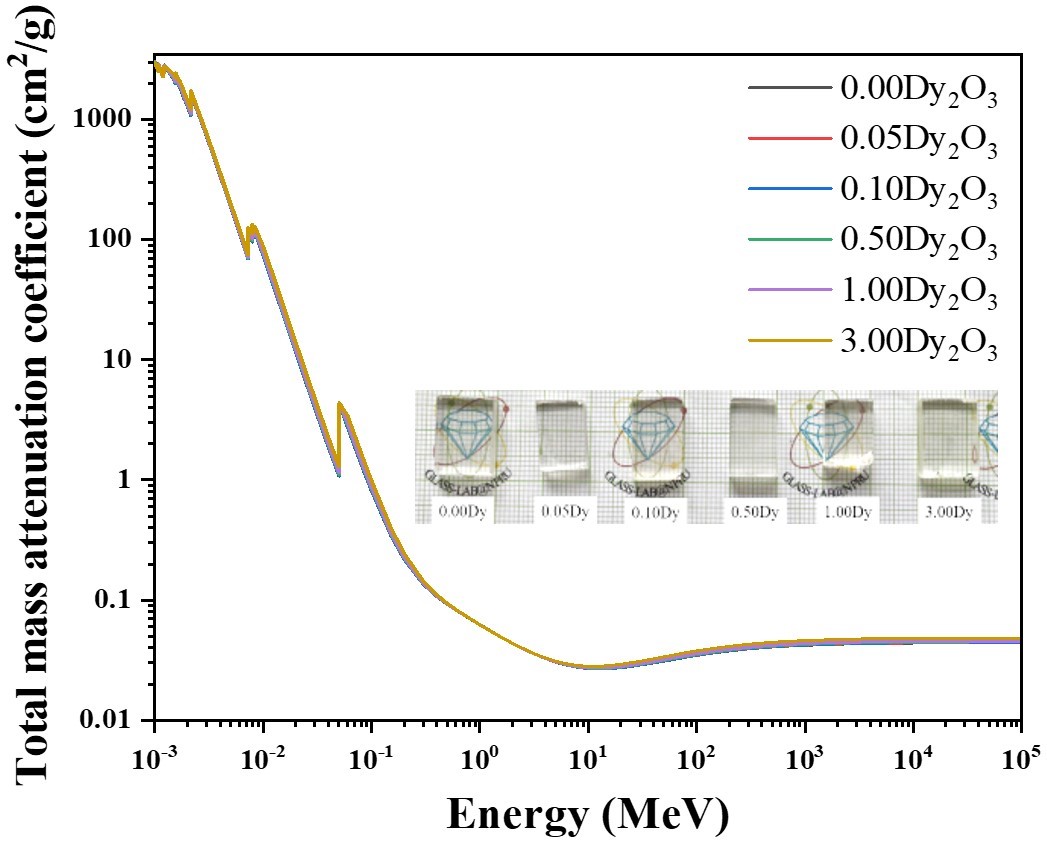The interacted characteristically study of alpha, proton, neutron, and gamma radiation against Gd2O3-Na2O-Al2O3-P2O5 glass system doped with Dy3+: Theoretical investigation
DOI:
https://doi.org/10.55674/cs.v15i3.251507Keywords:
Radiation shielding glass, Fast neutron removal cross-sections, SRIM simulation , Phy-XAbstract
The radiation shielding properties and fast neutron removal cross-sections of Na2O-Gd2O3-Al2O3-P2O5 glass system doped with Dy3+ were calculated by theoretical approach using the Phy-X program. However, charged particles were simulated via SRIM coding. The result found that density and molar volume of the samples increase with increasing of Dy2O3 concentrations. For radiation shielding properties, increasing Dy2O3 concentrations impact with the mass attenuation coefficient (MAC), effective atomic number (Zeff), and effective electron density (Neff) and also corresponds to the gamma energy ranges. In other hands, increasing density and the MAC are not result directly with neutron cross-sections. For charged particles, the total mass stopping power (TMSP) of both particle as proton and alpha particles depend on the medium that charged particles traversed and also rely on number of ions.
HIGHLIGHTS
- Calculate and analyst the rediation shielding parameters by Phy-X program.
- The charged particles were simulated via SRIM coding.
- The study of radiation shielding properties Na2O-Gd2O3-Al2O3-P2O5
GRAPHICAL ABSTRACT

References
M.I. Sayyed, H.O. Tekin, M.M. Taki, M.H.A. Mhareb, O. Agar, E. Şakar, K.M. Kaky, Bi2O3-B2O3-ZnO-BaO-Li2O glass system for gamma ray shielding applications, Optik (Stuttg). 201 (2020) 163525.
A. Khanna, S.S. Bhatti, K.J. Singh, K.S. Thind, Gamma-ray attenuation coefficients in some heavy metal oxide borate glasses at 662 keV, Nucl. Instruments Methods Phys. Res. Sect. B Beam Interact. with Mater. Atoms. 114 (1996) 217 – 220.
W. Cheewasukhanont, K. Siengsanoh, P. Limkitjaroenporn, W. Chaiphaksa, The properties of silicate glass specimens for photon, neutron, and charged particles shielding : The roles of Bi2O3, Radiat. Phys. Chem. 201 (2022) 110385.
K.J. Singh, N. Singh, R.S. Kaundal, K. Singh, Gamma-ray shielding and structural properties of PbO-SiO2 glasses, Nucl. Instruments Methods Phys. Res. Sect. B Beam Interact. with Mater. Atoms. 266 (2008) 944 – 948.
U. Kaur, J.K. Sharma, P.S. Singh, T. Singh, Comparative studies of different concretes on the basis of some photon interaction parameters, Appl. Radiat. Isot. 70 (2012) 233 – 240.
O. Agar, M.I. Sayyed, F. Akman, H.O. Tekin, M.R. Kaçal, An extensive investigation on gamma ray shielding features of Pd/Ag-based alloys, Nucl. Eng. Technol. 51 (2019) 853 – 859.
K. Kaur, K.J. Singh, V. Anand, Correlation of gamma ray shielding and structural properties of PbO-BaO-P2O5 glass system, Nucl. Eng. Des. 285 (2015) 31 – 38.
I.El. Mesady, S. Alawsh, Optical and luminescence properties of silicon doped alumino-phosphate‑sodium glass system, J. Non. Cryst. Solids. 482 (2018) 236 – 242.
P. Kaur, D. Singh, T. Singh, Heavy metal oxide glasses as gamma rays shielding material, Nucl. Eng. Des. 307 (2016) 364 – 376.
P. Kaur, K.J. Singh, S. Thakur, P. Singh, B.S. Bajwa, Investigation of bismuth borate glass system modified with barium for structural and gamma-ray shielding properties, Spectrochim. Acta - Part A Mol. Biomol. Spectrosc. 206 (2019) 367 – 377.
S. Kaewjang, U. Maghanemi, S. Kothan, H.J. Kim, P. Limkitjaroenporn, J. Kaewkhao, New gadolinium based glasses for gamma-rays shielding materials, Nucl. Eng. Des. 280 (2015) 21 – 26.
Neutron scattering lengths and cross sections, https://www.ncnr.nist.gov/ resources/n-lengths, 13 October 2021.
E. Şakar, Ö.F. Özpolat, B. Alım, M.I. Sayyed, M. Kurudirek, Phy-X / PSD: Development of a user friendly online software for calculation of parameters relevant to radiation shielding and dosimetry, Radiat. Phys. Chem. 166 (2020) 108496.
W. Cheewasukhanont, P. Limkitjaroenporn, M.I. Sayyed, S. Kothan, H.J. Kim, J. Kaewkhao, High density of tungsten gadolinium borate glasses for radiation shielding material: Effect of WO3 concentration, Radiat. Phys. Chem. 192 (2022) 109926.
F. Ziegler, P. Biersack, D. Ziegler, SRIM the Stopping and Range of Ion in Matter, SRIM Co. 2835 Cox Neck Rd. Chester, Maryland 21619 U.S.A., 2008.
M. Shoaib, R. Rajaramakrishna, G. Rooh, N. Chanthima, H.J. Kim, C. Saiyasombat, R. Botta, N. Nuntawong, S. Kothan, J. Kaewkhao, Structural and luminescence study of Dy3+ doped phosphate glasses for solid state lighting applications, Opt. Mater. (Amst). 109 (2020) 110322.
N. Chanthima, Y. Tariwong, J. Kaewkhao, N. Sangwaranatee, White light emission of Bi2O3-B2O3-P2O5 glasses doped with Dy3+Ion, Mater. Today Proc. 43 (2018) 2498 – 2507.
N. Chanthima, J. Kaewkhao, Investigation on radiation shielding parameters of bismuth borosilicate glass from 1 keV to 100 GeV, Ann. Nucl. Energy. 55 (2013) 23 – 28.

Downloads
Published
How to Cite
Issue
Section
Categories
License
Copyright (c) 2023 Creative Science

This work is licensed under a Creative Commons Attribution-NonCommercial-NoDerivatives 4.0 International License.








